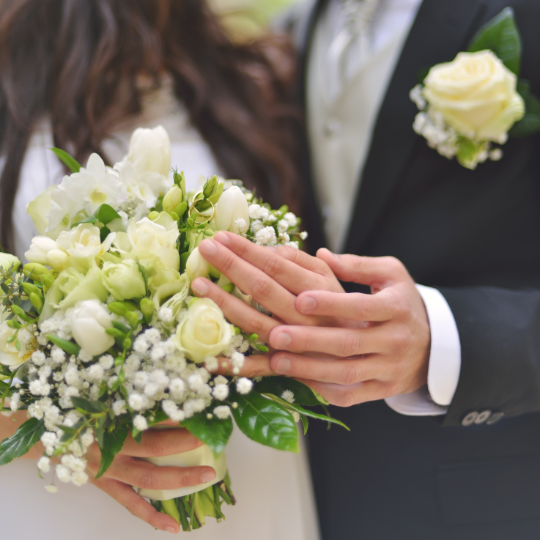The
Power of the Subliminal:
Celebrant-Led Ceremonies and Cultural Bias
/08
by © Jennifer
Cram - Brisbane Marriage Celebrant Originally published in The Celebrant, Issue 12, June 2022, pp 6-17
Republished 12/01/2023 with the permission of the Editor.
Categories: | For Celebrants| Wedding Ceremony | Inclusive Weddings
A word to
non-celebrant readers
But looking at wedding ceremonies as culturally loaded events that send subtle (and sometimes not so subtle) messages influenced by Class Culture, Christian Culture, Consumer Culture, and Celebrity Culture is equally relevant to brides, grooms, and anyone involved in the wedding industry.
 Celebrant-led
weddings. The legal marriage ceremony of choice in
Australia and New Zealand, and an increasingly
popular choice for non-legal celebrations elsewhere,
have made an expectation of choice and
personalisation the norm.
Celebrant-led
weddings. The legal marriage ceremony of choice in
Australia and New Zealand, and an increasingly
popular choice for non-legal celebrations elsewhere,
have made an expectation of choice and
personalisation the norm. Celebrant-led weddings have made progress towards achieving the kind of ceremony envisaged by Khoren Arisian in his 1973 book, The New Wedding; ceremonies in which an attempt is made, through words and gestures, to present an honest personal view of human relationships in today’s world. [1]
Nonetheless, we must ask ourselves whether we have merely tweaked rather than reinvented the traditional white wedding.
For example, to quote Arisian again:
Even in many otherwise up-to-date ceremonies, the notion of women as chattels survives in the minister’s question to the father: “Who gives this woman to be married to this man?” Semantic upgrading of the question to “Who presents the bride?” does not fully conceal matters. Why, after all, should the bride be singled out for presentation? [2]We market our celebrant-led weddings as more colourful and more personal than the alternatives. Many of the ways we have tweaked the traditional do achieve both of those things. Who doesn’t love a flower dude substituting for a flower girl? Or a ring dog? Or a bevy of bridesmaids boogieing down the aisle? Who doesn’t wax sentimental over personal vows spoken from the heart?
Closer examination, however, reveals that the structure, the assumptions, and the beliefs about weddings and marriage that permeate both the overt and the subliminal messages of celebrant-led marriage ceremonies haven’t evolved much beyond the traditional and (culturally) white wedding, what most of us in Australia, and from evidence, everywhere else in the English-speaking world, think of as the "proper" way to get married. And that makes a celebrant-led wedding a culturally loaded event. An event shaped by multi-layered and multifaceted cultural influences that underpin the inherent whiteness of the ceremony. Class Culture, Christian Culture, Consumer Culture, and Celebrity Culture, liberally laced with Patriarchal Values, are all simultaneously in play with, on occasion, invented traditions, and appropriated or mis-identified of customs and traditions borrowed from other cultures.
Wedding ceremonies convey subtle messages, sometimes through body language and choreography, sometimes through the words the celebrant uses, sometimes through the words the couple and others participating in the ceremony use. All too frequently, it is a message that hasn’t kept pace with legal advances and contemporary social views: It’s the bride’s day, but it is the husband’s marriage.
It's a message that is not only at odds with 21st century reality, but one that makes no sense for gender-diverse couples. It is a message that we must individually and collectively change if we are to move forward with marriage equality in its full sense, as opposed to an awkward differentiation between “marriage” and “gay marriage”.
Celebrant-led
weddings allow potentially unlimited
choice
Enter personal choice afforded by celebrant-led weddings and what I call weddings as a competitive sport becomes a social phenomenon, one that deflects attention from the values conveyed by the ceremony and impacts significantly on how much couples spend and what they spend it on.
.
Weddings are
about values
Early in my career I witnessed another celebrant complain that he had to almost force a couple to kiss. No-one commented that there is no legal requirement to kiss. No-one asked why he felt that a kiss was required. When I asked what their first names were, the reason was obvious. Any PDA would have been cultural anathema.
Almost invariably, when a couple is not 100% culturally Anglo-Australian I have to assure them that what the media feeds them is neither a legal nor a cultural requirement, and give them a personal guarantee that their own cultural values, particularly those around modesty, public displays of affection, and respect for elders, can and will be respected in their wedding within the legal framework mandated by the Marriage Act.
To do better we need to acknowledge the multiple “white”, Anglo, cultural roots of the ceremonies we seek to change, starting with class culture.
Class
Culture and the White Wedding
Class culture contributes to blowing the budget and including customs taken straight out of upper-class social custom. This may not cause much harm, Except for one thing. It is British upper-class culture. Which means that the traditional white wedding is culturally white, through and through.
The societies in which we celebrants live and work are culturally diverse. This is a reality that, I believe needs to fuel frank conversations about how we can actively change the way ceremonies, services, and the media are very much skewed towards culturally “white” weddings.
It’s not going to be an easy fix. We are still at the stage in the wedding industry where anything, or anybody, that doesn't fit into the white culture box is deemed exotic or alternative. Invented traditions, such as the Sand Ceremony, are often falsely attributed to an indigenous or "long-ago and far-away origin" to give them some authority. And there is a distressing level of cultural blindness still evident, not only in the marketing of celebrants’ wedding-related products and services, but in meaningful integration. Celebrants who come from other cultural backgrounds tell me people still assume that their niche market consists very largely, if not solely, of couples of a similar background. Yet, sadly, many couples will struggle to find a celebrant who is a good fit.
Christian
Culture and the White Wedding
Traditional church weddings are loaded with patriarchal assumptions about stereotypical gender roles. Despite this being well understood and discussed both in secular and mainstream religious circles, churches, together with many civil celebrants, continue to deliver a marriage ceremony that, in cultural essentials, has seen no significant change since mediaeval times.
The net result is that, for most people, there remains an expectation that a “proper” wedding ceremony will be a religion-free version of a church wedding ceremony. Movies, sit-coms, and reality shows reinforce this by equating tradition with romance. Watching Married at First Sight is like being a guest at a 1950s wedding. The giving away question is still asked. The father of the bride still walks her down the aisle. The groom is still given permission to kiss his bride. Mr and Mrs remains the default form of address, reflecting the assumption that the bride will abandon her identity and be subsumed into that of the groom. Readings and reflections on marriage may express gender role expectations.
Consumer
Culture and the White Wedding
Celebrity
Culture and the White Wedding
Celebrity Culture, of which the growth of the monetized Influencer is part, is a particular type of Consumer Culture. The product is a person who is famous in some way. What celebrities do is news. It is imitated. It influences what products and services people want, whether or not they actually need them. It drives the desire for luxe and lavish weddings, the success of which is measured by labels.
Where to from here?
The stumbling block will be, as Thomas Paine observed two and a half centuries ago: our long habit of not thinking a thing wrong, has given it a superficial appearance of being right, and that will raise a formidable outcry in defence of custom. [3]
To address the power of the subliminal in a wedding ceremony, we will need to go beyond understanding and eliminating gender role stereotyping. But that’s a good place to start, because we all have experience of gender role stereotyping in everyday life, and the subtle and hidden messages that reinforced that stereotyping until we became aware of them. Awareness changes everything.
Without making radical changes that will be obvious, we celebrants can send powerful message of equality through what we say, how we say it, and how we choreograph the ceremony.
The first step would be to run a critical eye over the questions you ask when working with a couple to plan their ceremony. How a question is worded can skew how it is answered, particularly in a situation where people are fearful of the consequences of getting it wrong, driving them to look for clues to point them to the “right” answer.
Having done that, turn to the choreography of the ceremony. The couple could walk in together, a logical choice if they have been living together for some time. An alternative is for both parents to walk with the bride to the top of the aisle. At which point they take their seats, and she walks alone towards the groom, who has stepped forward to meet her. Then, walking as equals, the couple moves to join their wedding party and the celebrant. You might also suggest that, at the end of the ceremony, the couple moves to greet their parents before they set off back up the aisle.
Small changes to the wording of the ceremony can make a huge difference. Instead of asking who gives/presents, address both sets of parents by name and ask for their blessing and support for the marriage. Invite the couple to seal their vows with a kiss or say nothing and just let them go for it!
Khoren Arisian conceived of the wedding as “the humanistic celebration for our time” in which “Enrichment of the individual identity of each partner is deemed superior to concern for the usual roles and expectations.”[4] Fifty years on, the rise of the celebrant-led wedding as the ceremony of choice gives us a real opportunity to make this a reality. Let’s do it.
[1] Arisian, Khoren. 1973. The New Wedding: Creating your own marriage ceremony. New York, Alfred A. Knopf, 1973 p. 15.
[2] Arisian p. 9
[3] Paine, Thomas. 1776. Common Sense. http://gutenberg.org
[4] Arisian p. 12
Related
Information
Thanks for reading!

pullin0 Things